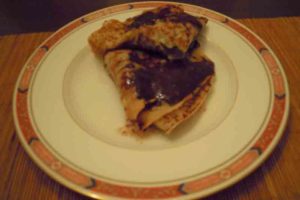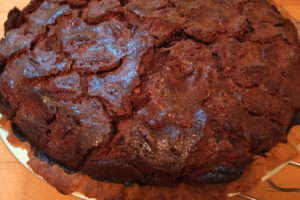If you’re looking for the perfect dessert for these hot summer days, here’s Vacherin Tropical to the rescue. It’s like a bracing plunge in a cold mountain lake on a blistering sultry day.
I first encountered a similar dish at Lespinasse, the posh New York City restaurant that closed in 2003. I had no idea how this dish of meringue with tropical fruits was made, but I decided that I must come up with my own version. Vacherin is defined as a meringue filled with fresh fruits, whipped cream, or ice cream. This contemporary take replaces traditional fruits with those from the tropics and eliminates the need for cream of any kind. Still it fully satisfies the sweet tooth. And it’s a marvelous blending of tastes and textures: sweet/tart; crunchy/smooth; pulpy/creamy.
Though at first glance the dessert appears complicated to make, it’s actually quite simple if done in small steps. Everything can be made ahead. The meringues will keep perfectly well for two weeks if stored in a tight metal cookie box. The fruits can be prepared one at a time and will keep for several days in the refrigerator.
In my attempt to simplify the dish, I removed the difficulties from the vacherin or meringue shells. The French generally pipe them through a pastry bag in elaborate layers and shapes. I despise using a pastry bag because it’s messy, time consuming, and wasteful. In fact, I’ve found that almost a third of every batter piped through a bag is left clinging to the inside of the canvas. I use one only when absolutely necessary. Besides, in this case you barely see the meringue for the fillings, so why waste the time on needless fussiness?
In New York, I find that most of the fruits are available in late June and early July. Fresh passion fruits are difficult to obtain, and it would take a large quantity to yield the necessary 3/4 cup. Fortunately, passion-fruit purée, which is excellent and essential to the dish, can be ordered from many outlets online. Also, many supermarkets carry it in the frozen-food sections. The Goya brand is especially prevalent. I’m lucky to find a fine French brand, Boiron, at Buon Italia, an Italian specialty store at the famed Chelsea Market, home of the Food Network.

I prefer the yellow mangoes for this dish because they tend to be less fibrous, but any variety will due. The guavas, which are difficult to find, are completely optional. If you are fortunate enough to get some, they add a wonderful piquancy to the dessert.
Begin by generously brushing two large baking sheets with melted butter. Then dust them with flour, knocking off any excess. Take a bowl about 3 1/2 to 4 inches in diameter, and mark off 9 circles on each of the baking sheets.

Mark rings on buttered/floured baking sheets.
Be certain that your egg whites are at room temperature before you beat them with 1 cup of sugar and 1 teaspoon of vanilla. Add a pinch of cream of tartar at the foamy stage to help the meringues hold their shape when baked. Then continue to beat until stiff peaks are formed. After you’ve sifted together the 1 1/4 cups of confectioners sugar with the tablespoon of flour, gradually sift a little at a time over the beaten egg whites. Here you must fold in this mixture gently so as not to deflate the egg whites. Once the batter is prepared, spoon equal portions of it into each of the 18 circles and spread it out evenly with the back of a spoon. You don’t need to make these perfect or even attractive because they won’t be seen in the finished dessert.

Spread the meringue in the circles.
Bake them at 275° on the bottom and middle racks of your oven for about 40 minutes. If they begin to color, lower the heat to 225°. Your finished meringues should be white, dry, firm to the touch, but soft and creamy in the interior. Let them cool completely on the baking sheets placed on wire racks. Then remove them gently with a metal spatula, storing them in cookie tins or tightly sealed plastic bags.

The baked meringues.
Next make the lime/passion fruit sauce. This takes 1/2 cup of fresh lime juice, 1/4 cup of passion-fruit puree, 2 teaspoons of gelatin, 3/4 cup of sugar, and water. Soften the gelatin in 1/4 cup cold water. Dissolve the sugar and salt in 1 1/2 cups of boiling water. Add the boiling mixture to the gelatin to dissolve it. Then incorporate the lime juice and passion-fruit puree. After this is refrigerated for several hours, you will have a soft slightly gelled mixture that can easily be spooned over the vacherins.
Peel 3 ripe mangoes. Scrape off any flesh that clings to the skins with a spoon. Place those scrapings, along with the flesh cut from 2 mangoes, the optional pulp scooped out of the guavas, 2 tablespoons of lime juice, and 1/2 cup of sugar in the bowl of a food processor.

Scooped out guava pulp, limes, and mango flesh.
Process until smooth. Then strain this mixture through a sieve into a small saucepan. The straining removes any of the fibrous elements from the mango, as well as the guava seeds if you used that fruit. You then warm this mixture with 1/4 teaspoon of gelatin over very low heat until the gelatin dissolves. Stir in 1/2 cup of passion-fruit purée.
At this point you should taste the mixture for sweetness, which will depend on the size and sweetness of the fruits you’ve used. You want the marmalade to have a bit of tang to contrast with the sweet meringues. Don’t worry about quantities when you make this marmalade. More or less fruit does not matter. When you have the mixture tasting as you like it, chop the flesh from the remaining mango into tiny cubes, and add it to the marmalade. Heat gently for two minutes, just to incorporate the chopped mango into the purée. You don’t want to cook the chopped fruit. When finished refrigerate for several hours.

The mango/passion-fruit purée with chopped mango.
Toast 1/2 cup of unsweetened coconut chips in a 350° stirring a few times, until the chips are light browned.
To assemble the vacherins, put one meringue into each serving bowl. Spoon a couple tablespoons of the lime/passion-fruit sauce on top.

Lime/passion-fruit sauce spooned over the meringue.
Finally, spoon about 1/4 cup of the mango marmalade over top, and sprinkle on some toasted coconut chips. Serve and enjoy.

The completed vacherin tropical.
To print or download the recipe, click here.




